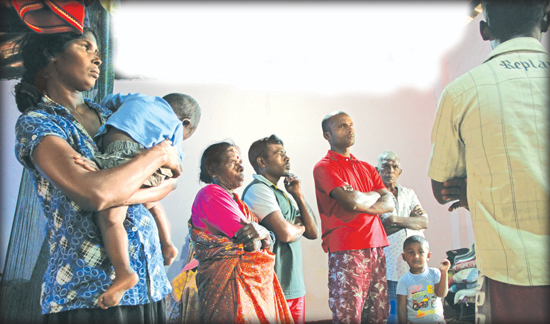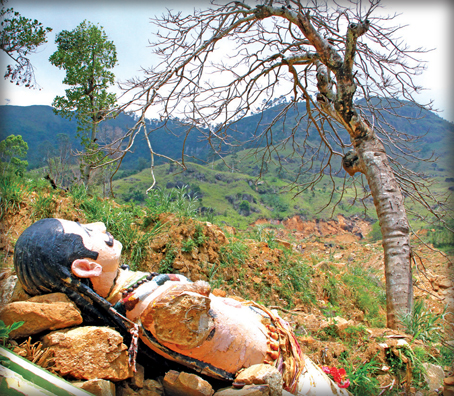|
Meeriyabedda...:
The agony continues
At precisely 7.15 a.m. on Wednesday, 29 October 2014, life in the
estate hamlet of Meeriyabedda, in the Badulla District, literally got
interred in tons of mud and rubble, in what is now known as one of the
worst earthslips in Sri Lanka. Two square kilometres of land shifted
axis in a matter of seconds, burying the entirety of the Meeriyabedda
Estate.
More than a 100 people were believed to have lost their lives in the
early morning devastation. However, days later, the toll was computed at
38 dead, over 1,200 displaced, and widespread destruction to property.
Among the dead were three children.
Among the buildings completely destroyed were seven line rows
(quarters), a temple, a community centre, several milk collecting
centres, a telecommunication centre, three estate bungalows, and several
houses and boutiques.
|

Families cramped for space in a classroom |
Close to 500 of the displaced were provided shelter at two schools –
the Shri Ganesha Tamil Vidyalaya in Meeriyabedda and the First Tamil
School and the rest in several makeshift welfare camps in the adjoining
areas.
The displaced families, many of them with small children were not
expected to remain in the temporary shelter for long. And many have
found alternate accommodation. But many still continue to be displaced
five months on, losing hope of the promised relocation and a home to
call their own.
Continuing nightmare
Devoid of the safety and familiarity of home, life for the displaced,
especially displaced in a harrowing manner, can be a continuing
nightmare. And forced to remain in temporary shelters for indefinite
periods, often cramped for space, sometimes devoid of even the basic
amenities, life can become misery uninterrupted. And utterly miserable
it is for displaced families still sheltered at Shri Ganesha Maha
Vidyalaya.
Cramped into a single classroom are eight families, with ragged saris
hung across ropes providing the only privacy. More squalor than
sanctuary, it is a heart- wrenching sight giving one an indication the
agony life continues to be for these families, who escaped with their
lives only to fall down a rabbit hole and into a life of utter
wretchedness.
The stark sense of despair ... the wretchedness... is all too
evidenced in the face of two frail, old people huddled together near a
makeshift toilet. Letchimi and Yogaraj, two of the displaced whose
combined work experience in the Meeriyabedda estate totals a grand 78
years (Letchimi 33 and Yogaraj 45), can’t quite comprehend why fate has
been so cruel to them. Warned not to return to the land they are
familiar with because of its susceptibility to future slips, they have
been in the temporary shelter wondering when their lives will take a
turn for the better or whether it ever will.
“Our diet contains dhal and soya-meat. Water is scarce,” they claim
as a matter of fact, concerned more with the worry that their lives have
been in limbo since the earth slip occurred nearly five months ago.
“What we really need is a permanent abode for us to live in,” plead
Letchimi and Yogaraj. Their plea finds resonance with Velu and
Kathiravel, two other long term estate workers and neighbours in misery.
The condition these displaced are forced to live in is cause for
concern. But the local PHIs Ravindra Piyaratne, while admitting there
are 64 displaced estate workers provided shelter at the school, claims
that the squalid conditions they live in are the fault of the displaced.
“They seem to be rather indifferent to primary health care and are
always non-cooperative with the health authorities,” he alleged, adding
that fortunately no infectious disease has broken out as yet. Even under
normal circumstances Shri Ganesha Maha Vidyalaya is poorly equipped and
lacks most of the basic facilities.
But converting it into a makeshift shelter has not only strained its
facilities, it has also deprived the children of a school, compelling
the parents to either keep the children at home or spend money they can
hardly afford to send them to schools in adjoining villages.
Students deprived
Palani Ariyandi Saradadevi, a mother forced to spend at least Rs 50
extra to send her children to another school, urges the authorities to
vacate the school of the displaced and reopen it for the students. “I
can’t continue like this and I don’t have the money,” she says.
But vacating the school of the displaced is not easy, as the hills
they lived in still remain unstable and they have nowhere else to go.
The land is not stable, there can be another earth slip anytime, says
Thalaiver Subramaniam.
Another estate worker explains that although they have been given
land with newly-built houses, they have been warned of potential
landslides and urged to stay away.
|

Statue of Hindu deity Mahamuni among the debris |
At the site where 37 people were buried alive, debris of the disaster
has surfaced in several places, a stark reminder of the tragedy that
engulfed an entire village. The disaster is beyond comprehension, but
giving into superstitious believes, some view it as the wrath of god
brought about by the people’s failure to make the proper sacrifice.
Gods must be angry
In fact among the debris that has surfaced in the partially destroyed
statue of a Hindu deity, brought from India long years ago. The deity
looks lost and forlorn, staring impotently at a dead tree that aptly
depicts the devastation the land suffered.
The displaced living in the Punagala factory camp are luckier than
their counterparts at Meeriyabedda. Several of them have been provided
with new houses by the estate management; although Rs. 2,500 is deducted
from their monthly wages towards the cost of construction. They are also
provided with electricity and water.
The displaced here are full of praise for the Security Forces that
were there for them in their hour of need. However, they are still angry
at the manner in which officials of the previous government treated
them, hoarding the relief sent by the people, rather than distribute the
food and other essentials needed by the people.
They were warned
“Three lorry-loads of food were condemned as unfit for consumption.
Others remain intact without being distributed among the needy. It is
rumoured that about 1,588 lorry loads had arrived. This is sufficient to
feed even the entire village” many point out, adding that if the aid
received had been properly distributed, each of the displaced would have
received Rs.20 a day.
The National Buildings Research Organisation had conducted research
and warned of possible landslides the Meeriyabedda estate locality.
The Grama Niladhari with Disaster Management officials had also held
a workshop at the Ganesha Tamil School with 275 participants and had
raised awareness among them of the impending disaster, instructing them
how to cope up with it.
However, as is human nature, the people of Meeriyabedda had chosen to
ignore the warning, convinced it was a ploy to acquire their lands.
Hindsight being 20-20 many estate workers now believe their lives
could have been different had they heeded the warning and got the estate
management to relocate them to a safe area.
However, the Superintendent of the Ampitikanda Estate pleads
ignorance about any landslide warnings, and claims that in the awareness
programs he had taken part in there had been no proposal at all to
evacuate the people from the area.
Written by a Staff Reporter with input from Aruni Muthumali
|

